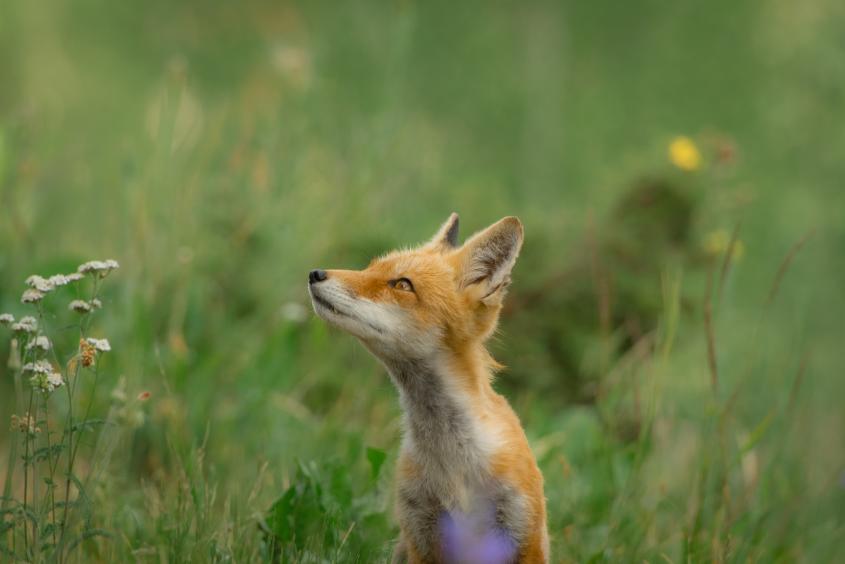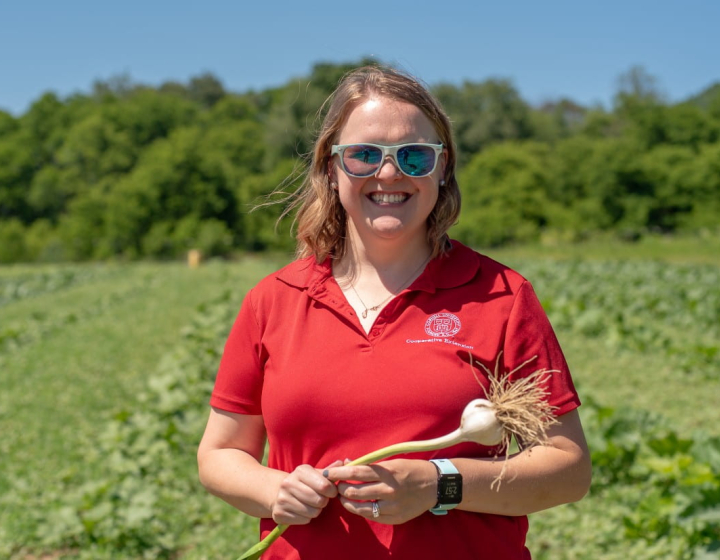Wildlife Watchers: How CVM research and surveillance protects nature in New York state
It was fungus that tipped the scale for the New York State Department of Environmental Conservation (DEC) —fungus that encircled the nose of the little brown bat, and swiftly decimated the species’ population after the first confirmed occurrence in 2006.
“White nose syndrome was a devastating disease that has resulted in the death of approximately 80 percent of hibernating bats in parts of the United States,” says Elizabeth Buckles ’92, associate clinical professor at the College of Veterinary Medicine and a leading researcher on the disease. No one had ever seen it before, she says, and the state lacked the infrastructure to respond.
The DEC sent samples to Ithaca, where Buckles performed necropsies on the bats. Over and over, she saw the same symptoms—low weight, damage to wing membranes, and of course the disturbing white ring of fungus around the animal’s nose. A partner at the National Wildlife Health Center ultimately cultured the bat-killing fungus: Pseudogymnoascus destructans, spread by contact—either bat-to-bat or from hikers who transport infected soil in their shoes. “We were at the epicenter,” says Buckles, “and we realized that we needed a structure.”
When the fungus struck, the DEC was already working with the college to monitor and advise on cases of avian influenza, chronic wasting disease in deer, West Nile virus, rabies, and so much more. “They felt like they were going to keep getting hammered and they needed help,” says Elizabeth Bunting, wildlife veterinarian at the college. “We are seeing more diseases now and that may be because we have a lot more stressors on wildlife than we’ve had before.”
The college has long been a source of knowledge and impact for New York’s wild animals and ecosystems. CVM researchers constantly monitor and study the ecological health of the state’s environment. As they watch over New York’s forests, streams, and skies, they're hunting for powerful solutions and interventions wherever they can.
A unique partnership
After the devastation wrought by white-nose syndrome and the looming threat of other diseases, the DEC approached the college and pitched a partnership that would become the New York State Wildlife Health Program. The program works to develop high-quality scientific information about disease ecology in wildlife species through surveillance and research, with the goal of protecting and sustaining future wildlife populations. They do this by centralizing and assessing information. The DEC sends many of the wild animals their field biologists find to the lab at Cornell where Bunting, Buckles, and the rest of their team catalogue and analyze cause of death. Those animals that aren’t sent to the lab are still logged by DEC researchers who perform the necropsies on their own and send in the samples. The program explores research questions using the data collected and in this way provides the backbone for policies and procedures implemented by the DEC.
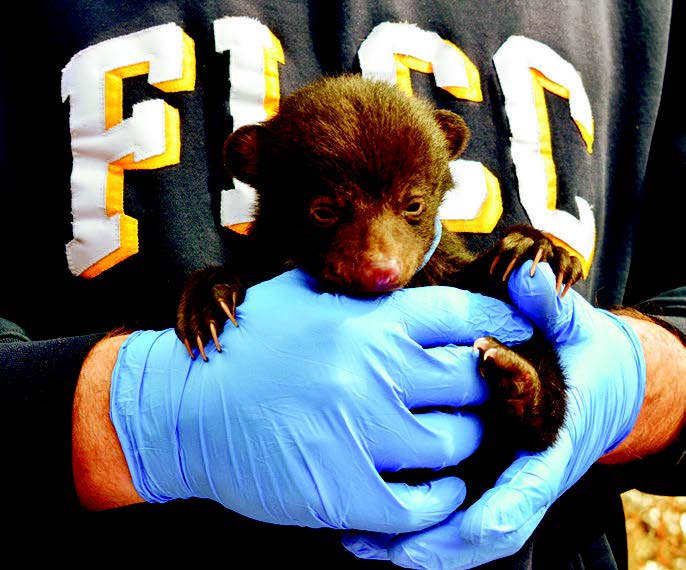
Having a diverse field of expertise is critical to its success—everyone from veterinarians and disease ecologists to anatomic pathologists and more are involved. “Most states don’t have veterinarians working for them, especially in the Northeast,” says Bunting, who was among the first to facilitate this partnership in 2010. “The program has good synergy because we can wrap our heads around things from different angles,” adds Krysten Schuler, wildlife disease ecologist and senior extension associate with the Wildlife Health Program.
Bunting and Schuler have worked together since the start of the program to spearhead training for those who come into contact with animals in the field, such as biologists, law enforcement officials, and even taxidermists. Implementing their procedures has not only improved the quality of the samples returned to them at the lab, but it has created a baseline of knowledge for research into disease. This research is then translated for the public or for use by the DEC in policy decisions. “If the DEC wants to look at whether something that’s being introduced is different, then we need to know what’s normal,” says Bunting.
What’s normal in other states might not be normal for New York, according to Schuler. “Wild animals don’t obey lines on a map,” she says.
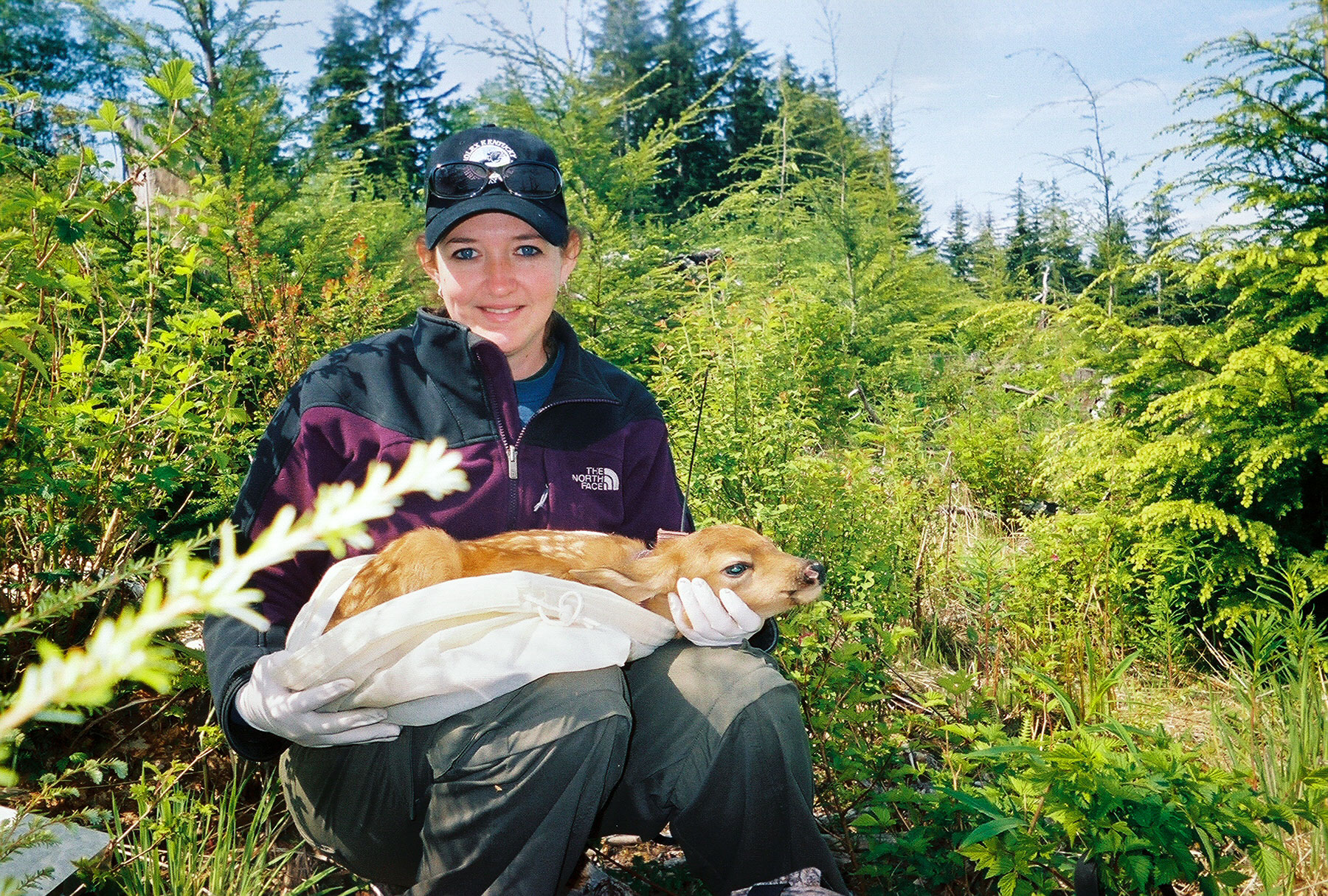
Nowhere is this more apparent than with white-tailed deer, which are integral to the hunting industry in the state. The Wildlife Health program is working to keep the state’s deer populations safe from chronic wasting disease (CWD). Widespread across the rest of the country and difficult to spot, a single case of CWD could have social, ecological, and economic consequences as serious as those of the decimated little brown bat. Currently, wild cases of the disease have shown up in 25 states already.
CWD is caused by a prion—a protein that folds in dangerous, infectious ways—that destroys the brain in infected cervids like deer, elk, moose, and caribou. Live animals spread
it through contact or through their saliva, feces, or urine. It causes difficulty in movement, increased anxiety, walking in obsessive patterns, and weight loss. It is universally fatal, though it may take time for the animal to succumb, giving the disease more time to spread to others. “People tend to think that diseases are static, but things can change. They can mutate,” says Schuler. “When we first started, the science certainly showed that CWD was bad. Then we learned it could stay in the environment for 16 years, and now there are troubling signs of it being able to jump to humans.”
The prions that cause CWD can bind to soil or be taken up in plants, where they remain infectious for years. Infected deer population decline heavily, and although there have been no human cases, CWD is similar to mad cow disease and the Centers for Disease Control and Prevention advises against eating venison from animals testing positive for the disease.
Thanks to the baseline of knowledge created by the Cornell Wildlife Health Program, Bunting and Schuler can examine conditions in New York over time and compare them to changes in other states. The threat of CWD was so great that in 2013 they compiled their extensive research to support a New York State Department of Agriculture and Markets ban on the import of live captive deer and elk. They provided an economic analysis which demonstrated that the wild white-tailed deer herd brought a yearly value of $1.5 billion to the state. The governor approved the ban.
This level of precaution has made New York one of the few states not to see a reoccurrence of CWD within its borders after an initial discovery in 2005. “We’re trying to help people understand that prevention is the most cost-effective tool we have,” says Schuler. “The disease almost certainly would have affected us by now.”
Policymakers were able to rely on the program for the scientific data they needed to make informed decisions. Bunting and Schuler are continuing to leverage their rich data archive from the last eight years. In 2017, they launched an interactive website that displays each animal case that DEC field biologists input from across the state, complete with notes and mapping capabilities. Currently, the site provides state government officials with information on state-wide projects and includes sophisticated case data and analytics. “I don’t know of any other system that people are using like this,” says Schuler.
Data gathering
In addition to white-tailed deer, this surveillance system tracks virtually every kind of wild animal in the state. Moose, for example, had returned to the Adirondack region in the 1980s after an absence of 120 years. The DEC has tracked moose numbers since the species’ return to the state, while Bunting and Schuler’s team examines and tests moose samples to assess reproductive status, infectious disease exposure, parasite load, and cause of death. Currently, moose populations are declining across North America, including in New York. The Cornell team might have discovered why.
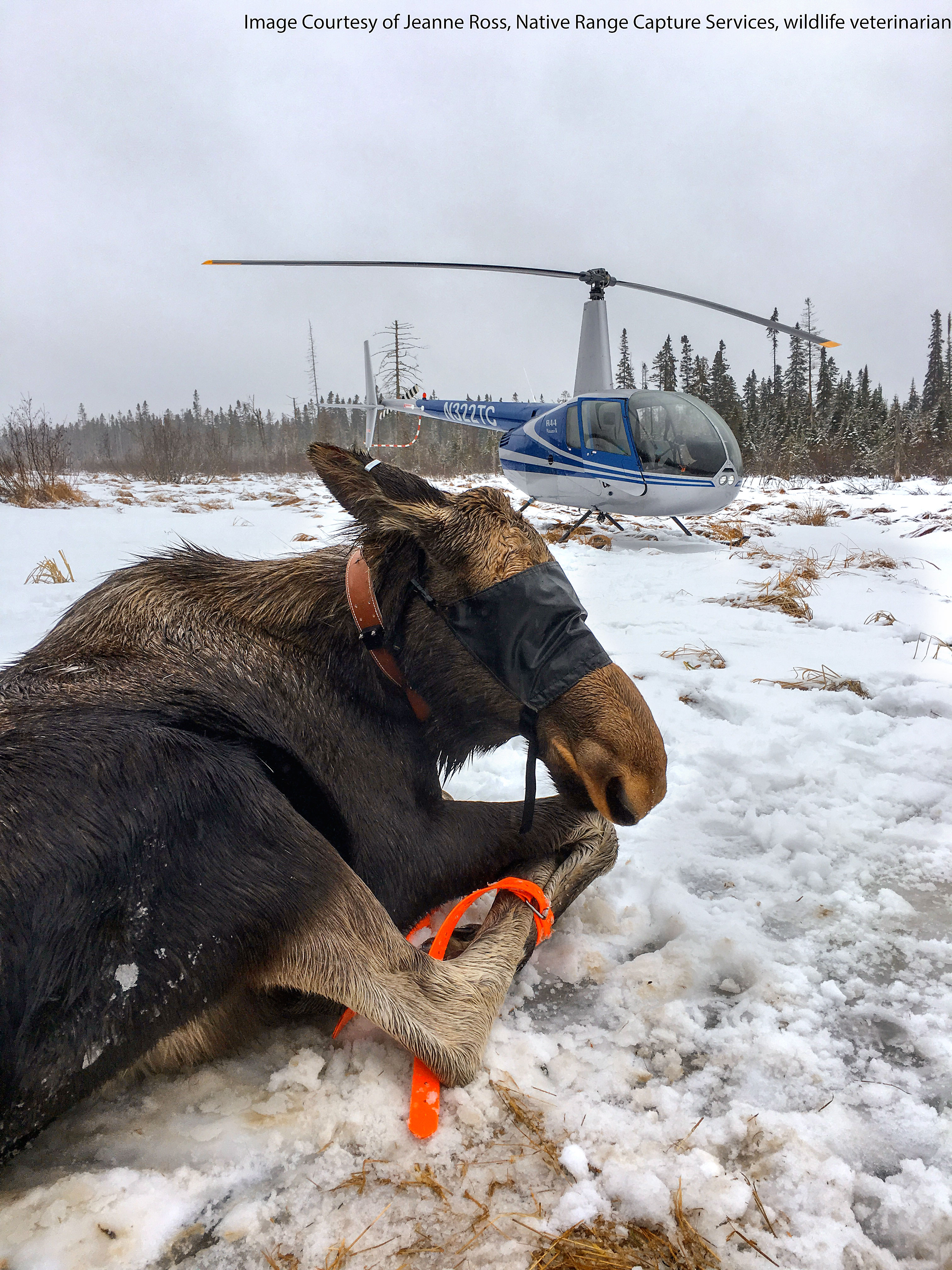
The program gathered blood samples from 26 live moose and necropsied dozens of others. Getting samples from live moose is no small task; moose are dangerous creatures and live in remote areas. The capture crews must perform “moose muggings” to get in and out safely. From a helicopter, two “muggers” locate and immobilize a moose using either a net or chemicals. They land, attach tracking collars, and collect samples for the scientists.
The samples collected from the mugged moose showed evidence of deer brainworm and giant liver flukes. Brainworm, like its name implies, is a parasite that affects the victim’s brain tissue and causes a higher mortality rate in moose than deer. Giant liver flukes feed on the host’s blood and cause liver damage, which opens up the possibility for more infections. “A lot of animals have parasites,” says Bunting. “We work to determine at what level they get problematic.”
These surveillance efforts will help the program develop a risk map for moose across New York, and will support population management programs. The program also studies the threat of mange in New York state black bears—the second leading cause of death for the animals after instances of trauma. In addition to severe hair loss, mange inflicts skin damage that leads to secondary infections and deadly hypothermia. The microscopic mites that cause the disease burrow into the animal on contact, which can come from interacting with another bear that has mange or even just walking by a mite in the environment.
While field biologists have seen mange for years in red foxes throughout New York, mange in bears is a relatively new phenomenon.
The program gathers as much information as possible about these cases, tracking reports of affected bears to determine the distribution and progression of the disease across the state. They’re also drilling deeper to discover how the bear mange mite is similar to the red fox mite. All of this information will guide management and treatment recommendations for bears in New York, just as such research contributed to their success with chronic wasting disease prevention.
“We can do all the research we want about wild animals and diseases,” says Buckles, whose work with the program has contributed to these endeavors, “but if someone isn’t in a position to use that knowledge to help the population, then what use is it? You want to see your work make a difference.”
Raptors at risk
In early January, students at Syracuse University witnessed a wildlife war on campus. A red-tailed hawk slowly circled on an updraft, eyeing its prey below to time a dive-bomb into the bushes. But this was no ordinary enemy—it was a northern harrier, lethargic and struggling through the foliage in the hawk’s territory.
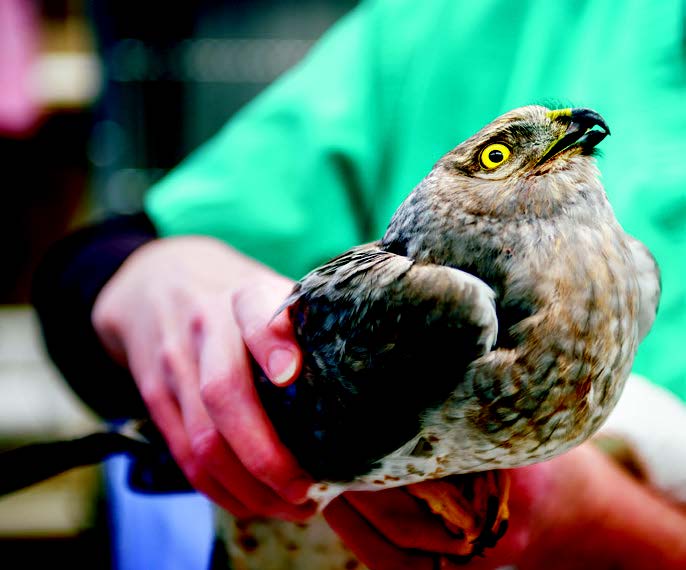
Before the hawk could deliver the final blow to this trespasser, an amateur ornithologist rushed in and saved the harrier, retrieving him from the bushes and taking him to Cornell’s Janet L. Swanson Wildlife Health Center. Veterinarians there discovered a low red blood cell count and poor ability to clot where they sampled his blood. The harrier was suffering from a severe case of anticoagulant rodenticide toxicity—rat poisoning.
All too frequently, chief of service at the center Sara Childs- Sanford DVM ’99 and her clinical teammates see wild raptors suffering from human-made causes—including state-classified threatened species such as this northern harrier or bald eagles half-dead from lead poisoning. These patients are just the tip of the iceberg. “Many, many more die in the wild without anyone knowing,” says Childs-Sanford. “We expect to continue to see a rise in the number of cases affected by toxins in the environment.”
While the clinicians at the Janet L. Swanson Wildlife Health Center focus on the individual patients, Bunting and her colleagues at the Wildlife Health Program monitor population
trends. In 2016 alone, the program examined 1,135 animals, performing 900 necropsies on everything from hawks to raccoons. They saw 602 birds total that year, 27 percent of which were raptors. Although rodenticides are meant for rodent pests, the creatures that eat such pests often suffer collateral damage—the dosage adds up over several meals, eventually killing a raptor just as easily as it will kill a mouse. In an effort to better tackle this issue, Bunting and her team have developed two of the first rodenticide-related coagulation tests for use in live birds.
The team also tracks lead poisoning, particularly in bald eagles. They’ve tapped into a DEC archive of 300 bald eagles in the last 22 years, finding that 83 percent had exposure to lead and 17 percent died from lead toxicity. “Eagle populations have rebounded, but lead is still a risk particularly to the adult, breeding-age birds,” says Schuler. The program has found that lead poisoning is second only to trauma as the cause of death in adult eagles.
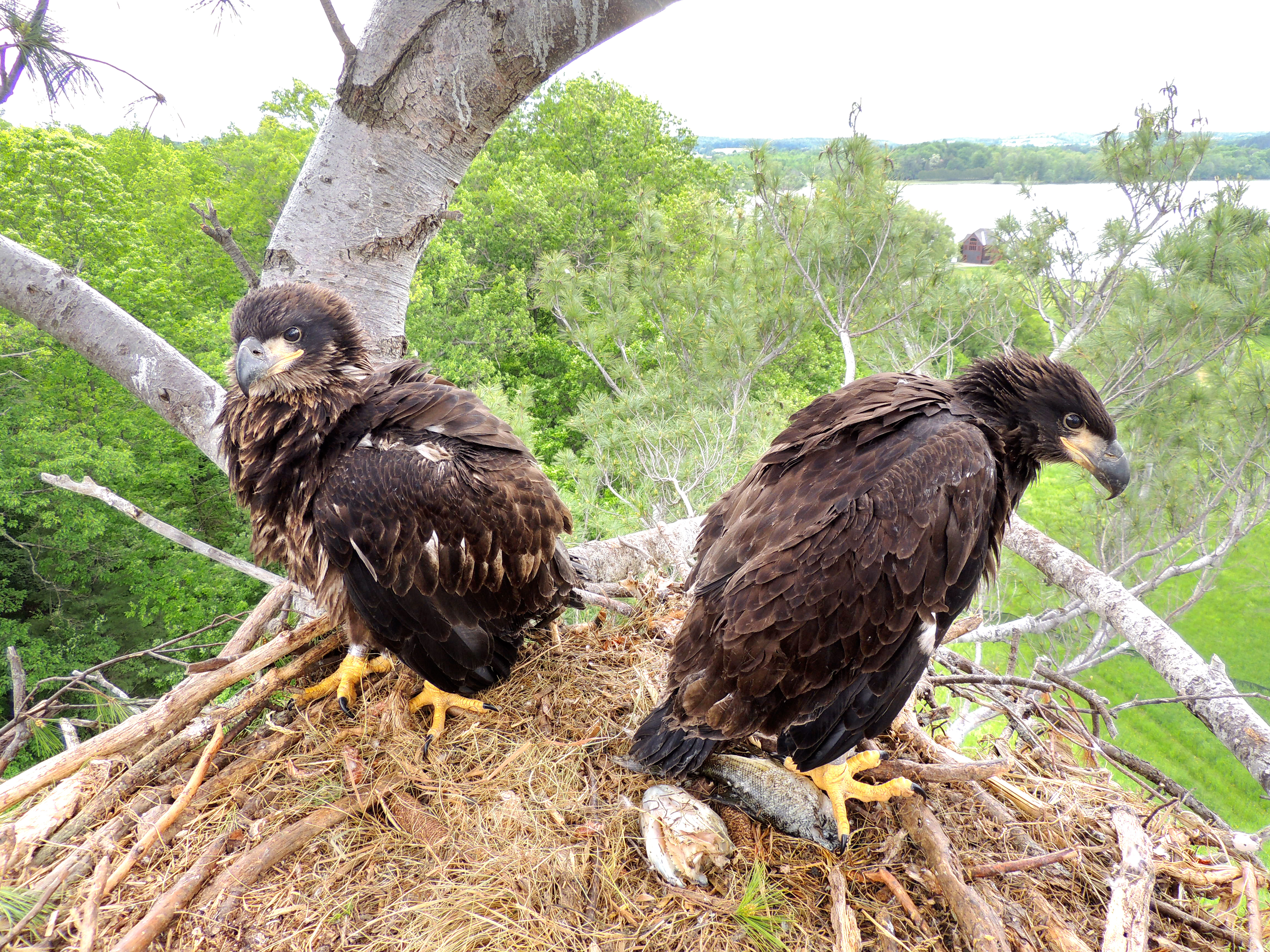
While the federal government instituted a national ban on the use of lead shot for waterfowl hunting in 1991, lead is still routinely used in some ammunition and fishing tackle. Bald eagles and other scavenging birds ingest spent lead from the environment or in carcasses harboring lead ammunition. To better understand the issue, the Wildlife Health Program will pool data with multiple state and federal agencies to analyze spent lead ammunition as a potential source of poisoning in bald eagles, as well as its long-term impact on the species.
Armed with this information, the Cornell researchers hope to influence policy and public awareness around manmade toxins, as they did with CWD in white-tailed deer.
Currently, they’re conducting information campaigns with the DEC to make people aware of the threats that rodenticide and lead pose to their pets, themselves, and the state’s environment. Recently, they helped Audubon in New York City produce brochures on the reach and consequences of rodenticide. “Assistance like this is a huge part of what we do,” says Bunting.
Schuler adds, “Our hope is that awareness increases around this issue, as there is definitely more work to be done.” Childs-Sanford and her team at the center see first-hand the effects human choices and policies can make. “Legislation regarding the use of these toxic substances by people has a major impact on the frequency and severity with which they affect wildlife,” she says.
CSI: Upstate New York
It’s a calm Friday night in 2006. Two DEC fisheries technicians are relaxing after work at the Cape Vincent Fisheries Station just north of Watertown. The water below their dock is placid, the early May air just a bit crisp. All is as it should be after a busy work week.
But something makes the employees take a closer look at the water around them. Perhaps it’s a muted splash or the way the water darkens. When they stoop to examine, they suddenly realize there is death beneath the surface: hundreds of dead and dying round gobies just below their dock.
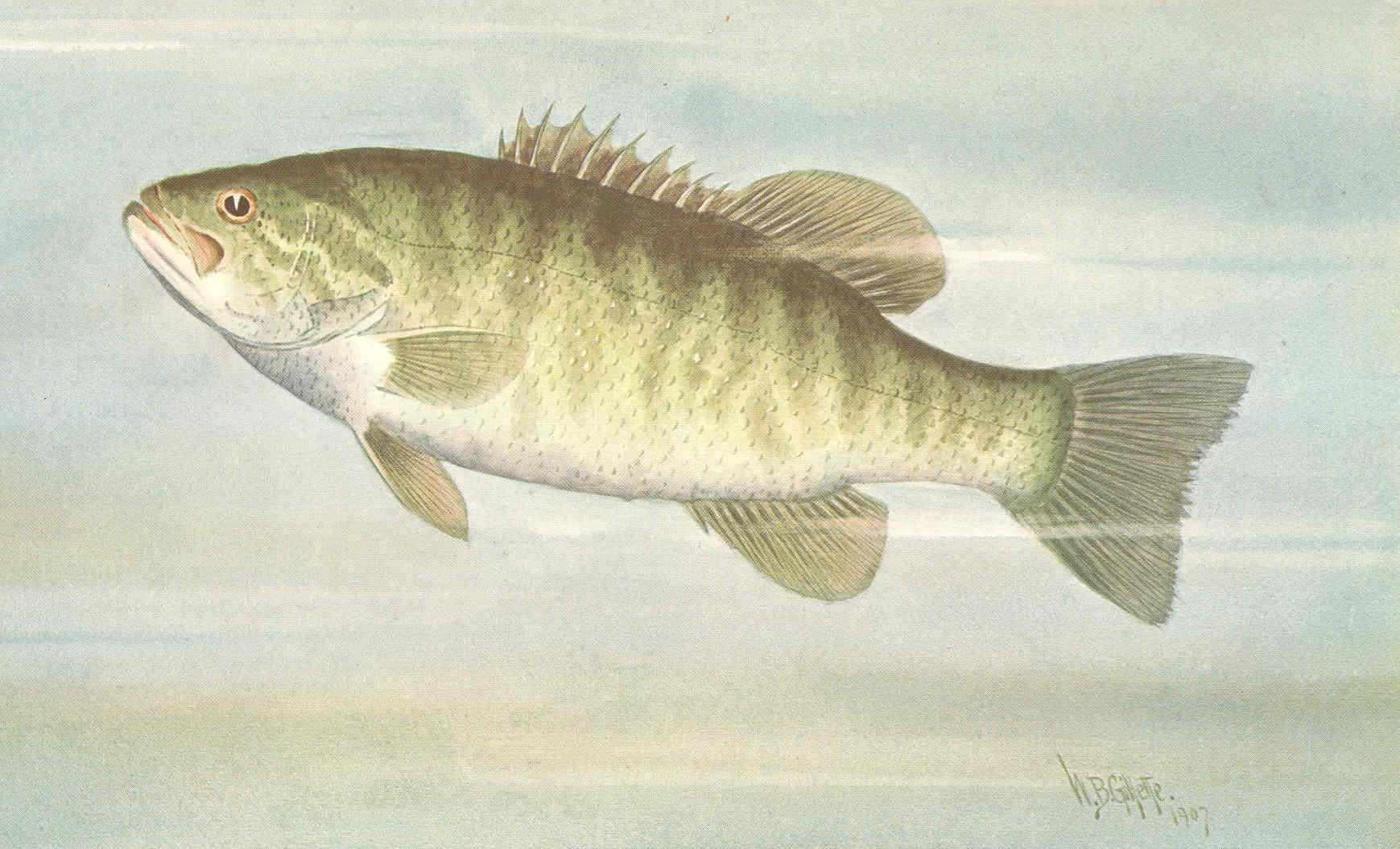
COME TO IF YOU REALLY WANT TO
KNOW WHAT HAPPENED.”
—ROD GETCHELL Ph.D. ’02
DEC staff aren’t easily startled. They deal with all sorts of wildlife on a daily basis, and have seen round gobies—an odd-looking invasive species—many times before. But this is a massive die-off happening before their very eyes. They scratch their chins, wondering at the cause and hoping the man who can solve the mystery is still at his post 150 miles away in Ithaca.
Enter Rod Getchell Ph.D. ’02, assistant research professor: “If a fish dies, I’m now the person you come to if you really want to know what happened.”
Getchell operates the Fish Disease Laboratory, a service lab providing disease diagnostic assistance to the aquaculture community, research community, and fish hobbyists in New York. Many times these diagnostic inquiries lead to more in-depth research investigations in fish health issues, and this clutch of round gobies—23 of which the employees retrieved from the chilly waters of the Upper St. Lawrence River—proved to be no exception.
Getchell suspected that the fish’s death knell was likely due to viral hemorrhagic septicemia virus (VHS), undiagnosed as yet in the area.
“The fish had all these little hemorrhagic spots in the muscle and the organs,” says Getchell. “I thought, wow, that looks just like VHS. There were reports that VHS had been detected by Canadian scientists the previous year, but I didn’t think it would ever show up here.”
At that point, only two other cases had been confirmed in North America, both in the Great Lakes or connected rivers. Here it was now in the Fish Disease Lab like a harbinger of doom; the Great Lakes would face widespread die-offs for the next two years due to VHS. The prognosis for other wild fish species wasn’t looking good; the round goby is a fish that crowds out other species, and it had now brought a disease that could prove fatal to its native neighbors. Symptoms of VHS vary, though most cases include hemorrhaging in major organs and body surfaces like skin and fins.
Getchell’s mentors Paul Bowser ’70 and James Casey spent over a decade leading a team of students studying all aspects of VHS and this deadly virus. For Casey, an associate professor of microbiology and immunology, the potential to track VHS in the Great Lakes with advanced technology was what drew him into environmental studies.
“Technology needed to be developed to look at viruses in the Great Lakes. VHS was an amazingly large outbreak and devastated the fish community,” he says. “I got hooked.”
This curiosity led him to develop the genetic tests the college uses to assess water samples from across the state. He’s looking for environmental DNA, also known as eDNA, traces of life in the water that come from creatures passively shedding cells. “We—mammals, humans, fish, amphibians—all shed skin cells,” says Casey. “If a deer is drinking in a stream, when you collect water downstream you can tell.”
Tracking wildlife with citizen science
To develop a surveillance network of New York’s waterways, Casey and his colleague Donna Cassidy-Hanley Ph.D. ’74, senior research associate in the Department of Microbiology and Immunology, decided to put eDNA technology in the hands of New York students by creating the FishTracker Program. Supported in part by a USDA HATCH grant, the program enables teachers and their middle- and high school-aged students to collect eDNA samples from local waterways that will help Casey and Cassidy-Hanley track where invasive species show up.
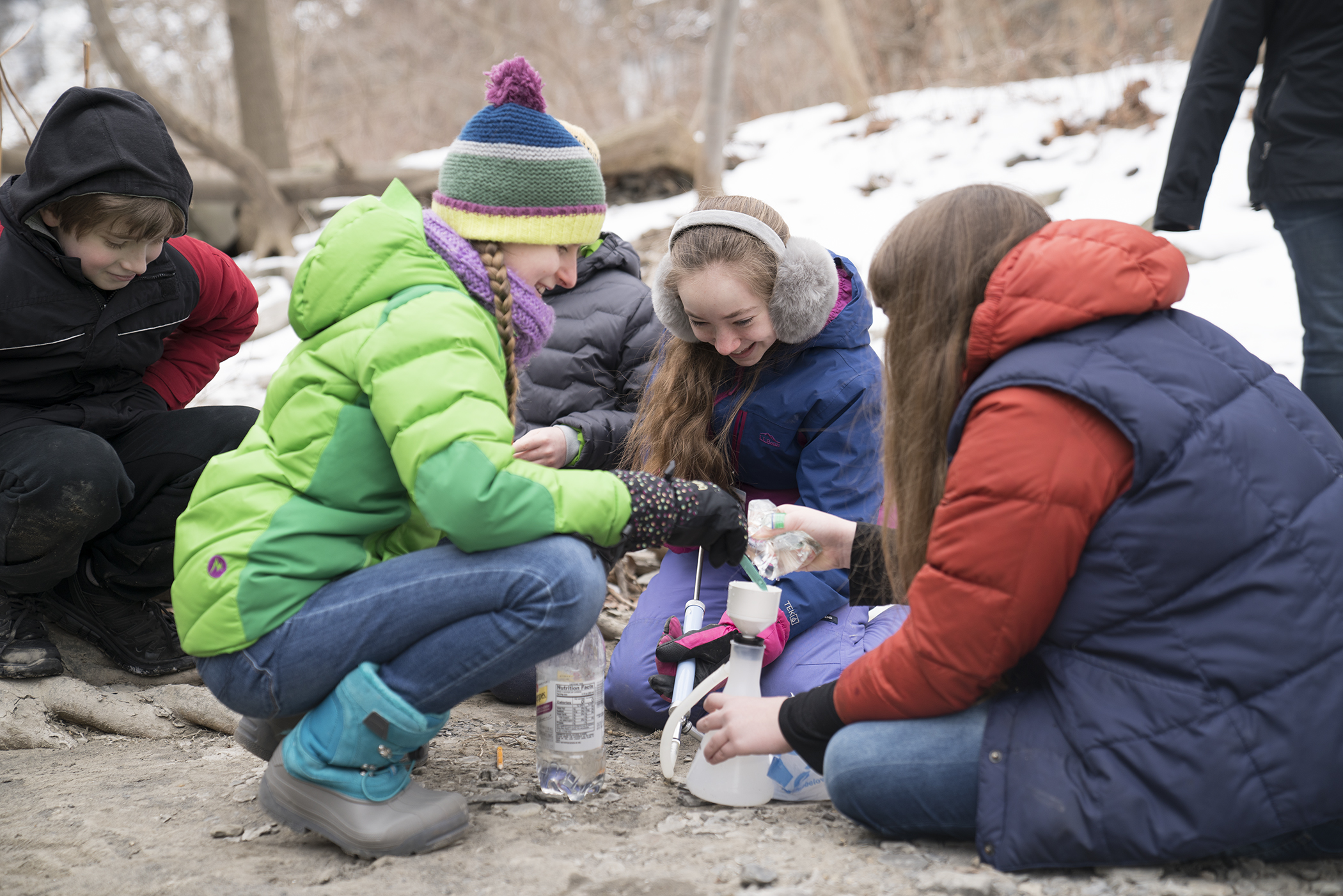
When they first started, they thought they’d only get five or six schools interested in the program. “We had 70 schools involved within the first few collection seasons, and the numbers continue to climb,” says Cassidy-Hanley. “At this point we’ve worked with over 2,000 high school students.” Armed with eDNA kits, students go to their chosen source of water and collect samples for examination. Cornell does the complicated genetics testing and shares the results with the students. They learn what species are present in the water sample and whether invasives have popped up in their area yet.
“This is real science, science that will make a diff erence, and the kids know that,” says Cassidy-Hanley, noting that activities like this spark a love of science in many students. “Seeing firsthand how invasives can affect fishing and boating, as well as the environment and the economy, helps students understand that science has a real impact on daily life.”
The Cornell team has created a website that maps each sample site, credits the school involved in the collection, and presents the test results for individual species in a visual, intuitive format. The maps represent a rich archive of data that will aid researchers in tracking the spread of round gobies and other invasive fish species.
“This program is such a quantum leap forward in terms of the real impact it has on the environment,” says Casey. “It’s advanced science that can be translated to a wide variety of other fields.”
The FishTracker Program currently tracks up to eight invasive species. This year they’re adding two endangered species. “They go hand in hand,” says Cassidy-Hanley. “Endangered species are often endangered because of invasives.”
When filtering for round goby, the FishTracker map shows their considerable progress along the state’s waterways. Here and there, like pockmarks on the face of New York, positive invasive fish spottings flare up in red. It was only a matter of time, researchers knew, that one would become a hotspot for VHS or another deadly disease.
When VHS showed up again, it was in Getchell’s backyard—literally. He lives on Cayuga Lake, where there was another die-off of round gobies in May 2017. He collected the samples in the spring and summer last year, and like Casey and Cassidy-Hanley, enlisted the help of a younger generation.
“I had the neighborhood kids catching round gobies for me,” he says. “We submitted a few others from around the lake to see if the disease was widespread.”
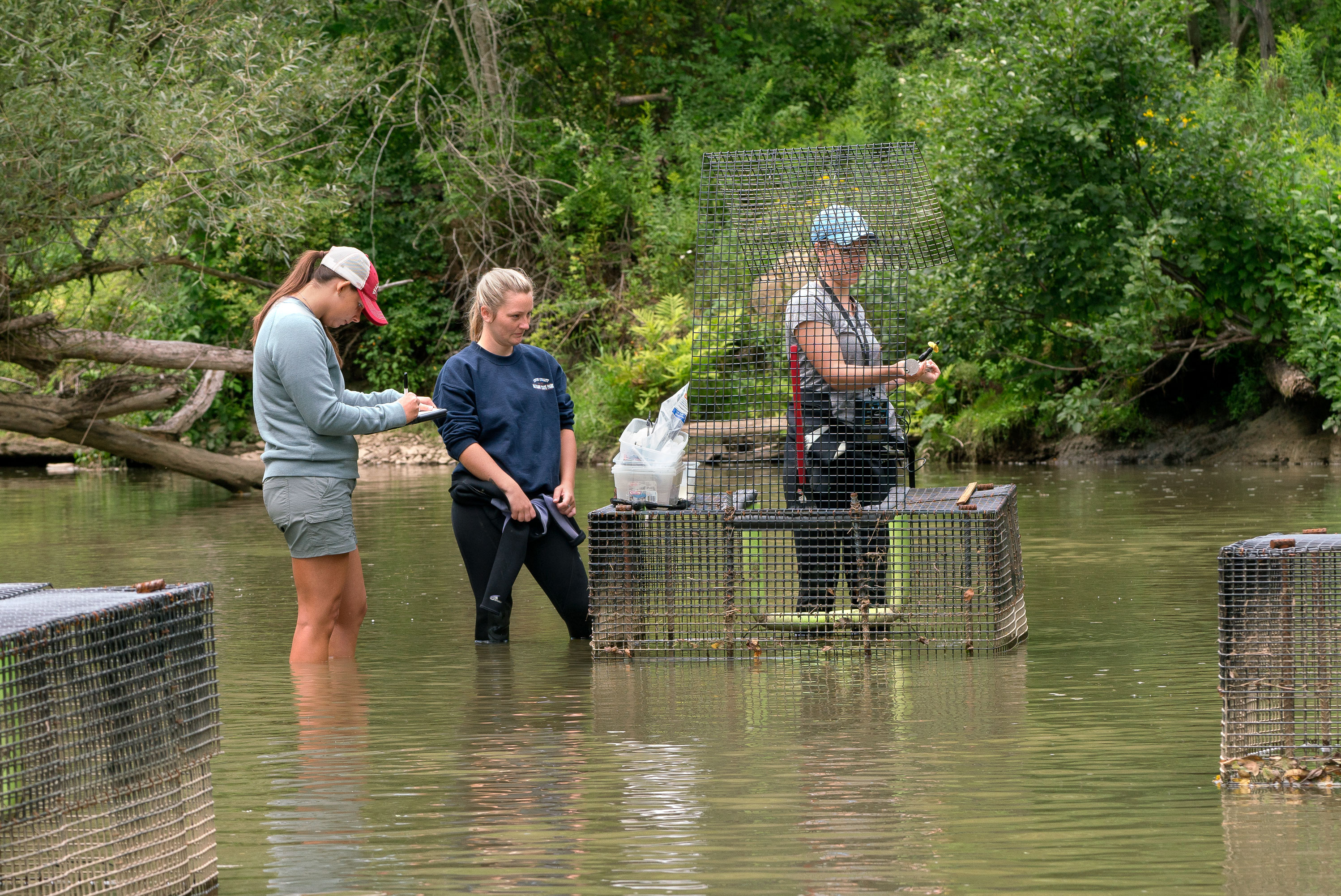
Getchell’s lab had the DNA of these fish sequenced. The results showed that the virus in Cayuga Lake was nearly identical to the Lake Erie strain. It fit with evidence that round
gobies had migrated down the Erie Canal from Buffalo. Those neighborhood kids, wildlife detectives in the making, did their part to solve the case.
Hell-bent on saving hellbenders
The Wildlife Health Program has dipped a toe in aquatic research and tracking as well, developing eDNA tools for the detection of ranavirus and amphibian species of concern, like the eastern hellbender. Living longer than 25 years and growing to be over two feet long, hellbenders are one of three giant salamanders in the world, and the only ones found in North America. They reside in the frigid waters of two river drainages in New York, their territory stretching down through Tennessee.
In the past decade, the New York population has declined by 40 percent. Manmade threats like pollution, dams, and the siltation resulting from agricultural practices and construction work all have contributed to the giant salamander’s decline.
The hellbender project started as a partnership between the Buffalo Zoo and the DEC, who were raising hellbenders in captivity but having little success with their survival when they were released. The Wildlife Health Program joined the team in 2014, designing a project to systematically monitor small groups of these animals to uncover the hellbender’s secrets and pinpoint why they were dying.
Their trials showed hellbenders in this captive family became infected with a deadly fungus, Batrachochytrium dendrobatidis. Within weeks of release, a majority of them died.
“Last summer we tested alternate release strategies with vaccinated and unvaccinated hellbenders,” says Bunting. “The goal is to assess long-term survival through radio tracking.”
After tagging the hellbenders, researchers released them into streams where the wild population is still found. Some of the animals moved freely while others were in large cages to protect them from predators. The program is currently analyzing the data collected from these releases and will continue the work this summer with another group in the
Susquehanna River.
“Figuring out ways to make the animals resilient in the environment is important for their long-term survival,” says Bunting.
Vital collaboration
While some puzzling questions continue to drive in-depth investigations into the mysteries of wildlife, it is the atmosphere of collaboration at the college and Cornell at large that turns questions into projects, projects into results, and results into policy.
“There are fewer boundaries for collaboration here,” says Buckles, “and when you’re dealing with wildlife issues, you need to be able to build a team.”
The health of our state’s environment and the creatures that comprise its ecosystem have never had more at stake than at this moment. With an anticipated population of over 21 million in New York by 2040, human actions alone could be enough to crush delicate creatures like hellbenders and spread invasive species like round gobies. Yet, human action also stands among these animals’ only hope. The college’s foundational work in the last decade has already generated protective measures for our state’s precious wildlife. If we’re lucky, those protections are just the beginning.
-By Melanie Greaver Cordova
This article was originally published in the Spring 2018 'Scopes magazine



